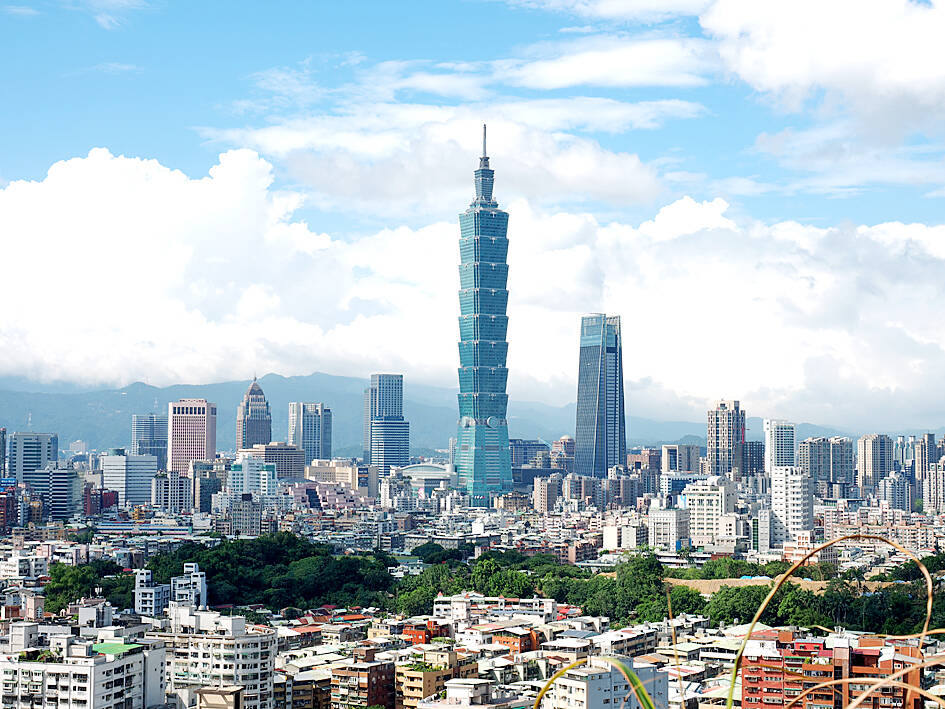Researchers have concluded a study on how weather and human activity influence Taipei 101’s frequencies and vibrations in an effort to enhance methods of monitoring building safety.
National Taiwan Normal University (NTNU) Department of Earth Sciences doctoral student Chen Yao-chieh (陳耀傑) and his team analyzed data from seismometers in Taipei 101 and meteorological data from the Xinyi weather station 1km away.
The study found that Taipei 101 has a higher frequency when temperatures rise, and a lower frequency when the wind blows vigorously, the university said in a statement on the study’s results.

Photo:EPA-EFE
Based on hourly data, the team found that human activity increased the vibrations detected by seismometers, it said.
Chen said that the “frequency” metric was significant because it is an important indicator of building safety.
Each building has its own frequency of vibration at different stages of its life span, he said, adding that new buildings have different frequencies than decades-old buildings.
Changes in frequency of a building due to material decay or structural renovation, which are usually observed through a process called “structural health monitoring,” could potentially affect its safety, he said.
Although data dating back to 2010 were included in the study, most of the research was based on data collected from 2014, as other data were affected by repairs or spotty Internet connections in the building, NTNU said.
Chen said the study not only has implications for Taipei 101 and other skyscrapers, but also for all buildings and bridges in Taiwan, which are prone to natural disasters such as earthquakes and typhoons.
Although sensors have been fitted on some bridges and buildings, the data that has been collected around Taiwan has not been continuous or even suitable for long-term purposes, in part because of the high cost of the equipment and labor, he said.
The government should start monitoring weak, older buildings or those believed to be unsafe, and later expand to more communities to enhance data-gathering methods, he said.
The research team also included NTNU earth sciences professor Kate Chen (陳卉瑄) and Huang Bor-shouh (黃柏壽) of the Academia Sinica Institute of Earth Sciences, the statement said.
The study was the cover story of the April edition of the Bulletin of the Seismological Society of America, a US journal for earthquake studies.

A relatively large earthquake may strike within the next two weeks, following a magnitude 5.2 temblor that shook Taitung County this morning, the Central Weather Administration (CWA) said. An earthquake struck at 8:18am today 10.2km west of Taitung County Hall in Taitung City at a relatively shallow depth of 6.5km, CWA data showed. The largest intensity of 4 was felt in Taitung and Pingtung counties, which received an alert notice, while areas north of Taichung did not feel any shaking, the CWA said. The earthquake was the result of the collision between the Philippine Plate and the Eurasian Plate, the agency said, adding

Snow fell in the mountainous areas of northern, central and eastern Taiwan in the early hours of yesterday, as cold air currents moved south. In the northern municipality of Taoyuan, snow started falling at about 6am in Fusing District (復興), district head Su Tso-hsi (蘇佐璽) said. By 10am, Lalashan National Forest Recreation Area, as well as Hualing (華陵), Sanguang (三光) and Gaoyi (高義) boroughs had seen snowfall, Su said. In central Taiwan, Shei-Pa National Park in Miaoli County and Hehuanshan National Forest Recreation Area in Nantou County saw snowfall of 5cm and 6cm respectively, by 10am, staff at the parks said. It began snowing

The 2025 Kaohsiung Wonderland–Winter Amusement Park event has teamed up with the Japanese manga series Chiikawa this year for its opening at Love River Bay yesterday, attracting more than 10,000 visitors, the city government said. Following the success of the “2024 Kaohsiung Wonderland” collaboration with a giant inflatable yellow duck installation designed by Dutch artist Florentijn Hofman, this year the Kaohsiung Tourism Bureau collaborated with Chiikawa by Japanese illustrator Nagano to present two giant inflatable characters. Two inflatable floats — the main character, Chiikwa, a white bear-like creature with round ears, and Hachiware, a white cat with a blue-tipped tail

HOLIDAY EXERCISE: National forest recreation areas from north to south offer travelers a wide choice of sights to connect with nature and enjoy its benefits Hiking is a good way to improve one’s health, the Forestry and Nature Conservation Agency said, as it released a list of national forest recreation areas that travelers can visit during the Lunar New Year holiday. Taking a green shower of phytoncides in the woods could boost one’s immunity system and metabolism, agency Director-General Lin Hwa-ching (林華慶) cited a Japanese study as saying. For people visiting northern Taiwan, Lin recommended the Dongyanshan National Forest Recreation Area in Taoyuan’s Fusing District (復興). Once an important plantation in the north, Dongyanshan (東眼山) has a number of historic monuments, he said. The area is broadly covered by